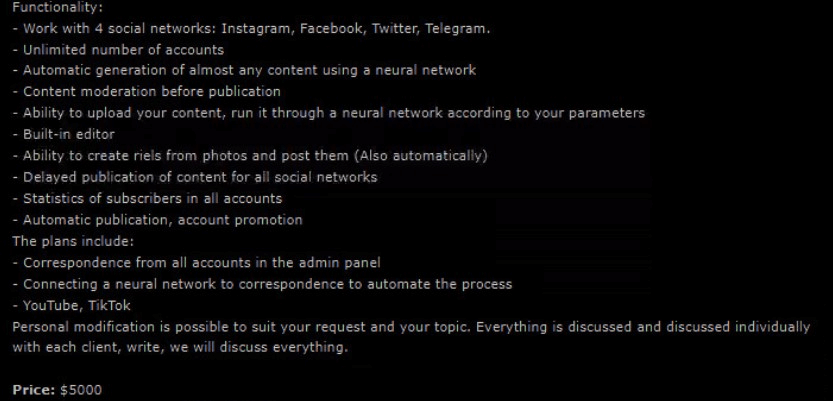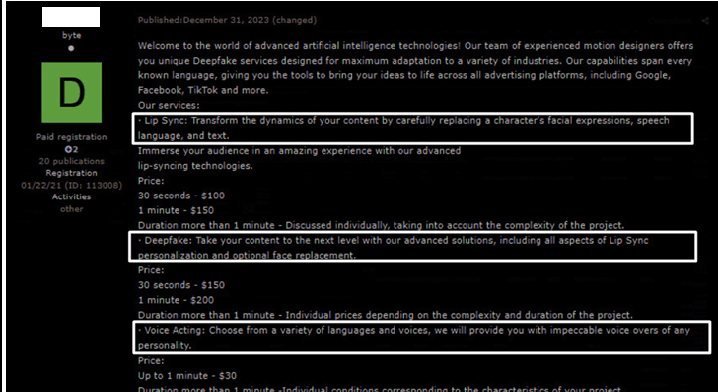Cybercriminals Officially Utilize Generative AI for Spam Campaigns, Social Media Impersonation and Verification Services
Highlights:
– Generative AI as a Cybercrime Tool: Cybercriminals are increasingly using generative AI for sophisticated cybercrimes, including social media impersonation, spam campaigns, and KYC verification services.
– AI-Powered Black-Hat Platforms: The rise of AI-driven platforms for creating and managing fake social media accounts, offering services to automate content generation and account activity for illicit purposes.
– Evolution of Spam and KYC Frauds: The integration of AI in spam services to bypass security controls and in KYC verification services for creating fake identification documents, signifying a new level of sophistication in cybercrimes.
Over the past year, generative AI and ChatGPT have continued to gain prominence in the ongoing struggle between attackers and defenders.
While many industries continue to explore the promise of AI to augment their capabilities, cybercriminals have also seen the powerful potential of AI in exploiting vulnerabilities and creating new attack vectors.
In the beginning of 2023, we exposed the initial hints of cybercriminals showing interest in using ChatGPT to create malware, encryption tools, and other attack vectors that leverage Generative AI. In addition, Russian cybercriminals immediately started to discuss how to bypass any restrictions to begin using ChatGPT for illicit purposes.
One year after the launch of ChatGPT, we observe that the use of generative AI has become the new normal for many cybercrime services, especially in the area of impersonation and social engineering. Some of them have realized the potential of generative AI as a differentiator to increase the effectiveness of their services and are even bragging about it.
In this blog we provide examples of 4 Russian underground AI-powered services that utilize generative AI built-in as part of their illicit tools and platforms:
- Black-Hat Platform for Social Media Impersonation on large scale
- Deepfakes Service
- Malicious Spam Tool
- KYC Verification Services
Case 1: AI-powered Black-Hat Platform for Social Media Impersonation
Fake social media accounts pose a significant cybersecurity threat due to their potential for malicious activities, brand impersonation, spreading disinformation, and much more.
In December 2023, an experienced threat actor, with official status of a seller in a “reputable” Russian underground forum offered for sale a ready-to-go platform that uses AI as a core module to generate content for social media platforms such as Instagram, Facebook, Twitter and Telegram. This can be used to almost fully automate maintenance of fake accounts on social media.



In one case study provided as an example, the threat actor shows generated content for female models. In another use case, the actor generated a series of fake profiles that mimic those of successful financial traders.

Figure 2 – Example of AI automatically generated content for social media.
The threat actor explained that he only realized just how powerful these tools are while working on his platform and he now offers two business models:
- Fake social media accounts management as a service – The threat actor and his team create all the necessary accounts on Instagram, Facebook, Telegram, and Twitter. They then automatically generate the content and promote the accounts to give them visibility and a sense of authenticity by joining relevant groups, “liking” similar topic accounts, etc.As proof of concept, the actor shows an example of 20 accounts of female models that were created and run using AI.The platform can simultaneously create content for over 200 accounts and generate daily posts, reels, etc. The AI-managed accounts attract followers and the traffic from all the accounts can be used for any malicious purposes.This managed service costs $50 for a single Instagram account per month and a bundle of connected fake social media accounts in 4 networks is $70. The minimum required order is for 10 accounts.
- A stand-alone platform – The platform is sold “as is” and the buyer handles the management of all AI-driven accounts by himself. One of the core features of platform ownership is the ability to upload content and enrich it using AI. The price of the platform is $5,000

Figure 3 – Integration of AI in the platform.
Case 2: AI Powered Deepfakes Service
On December 31st, the New Year’s Eve, another impersonation service was introduced in a major Russian underground forum.
This service is focusing on providing AI based deepfake services in three areas:
- Lip Sync – for 100$ per 30 seconds of the content
- Deepfakes which include lip sync and face replacement – for 150$ per 30 seconds.
- Voice Acting – for $30 per 1 minute.



Figure 4 – Deepfakes Service
Using services described in cases 1 and 2, separately, or combined can create possible impact in two significant areas avenues:
- Creation of fake profiles army in social media to promote certain political agendas or products.
- Impersonation of celebrities or corporate executives which can lead to severe brand reputation damage or initiation of cyber-attacks.
Case 3: AI-Powered Malicious Spam Tools and Services
Malicious spam is one of the oldest illicit services found on underground cybercrime forums. Spam is the most common initial vector for various attack scenario objectives such as phishing and credential harvesting, malware distribution, scams/fraud, etc.
One spam service was launched in November 2023 by a reputable threat actor who claims over 15 years of criminal experience. After receiving positive feedback on his service, he proceeded to make his spam services AI-powered, specifically by ChatGPT.
Using ChatGPT helped randomize the spam text and created a higher rate of success that the spam email would reach the victim’s inbox.

Figure 5 – AI integration in spam services.
As one customer of this service said, the AI-driven spam service helped him bypass anti-spam and anti-phishing controls of popular webmail services and achieved a 70% successful delivery rate to the targeted email address.

Figure 6 – Feedback regarding successful delivery.
Do you want to know how much the average hacker needs to invest to successfully deliver 70,000 malicious emails? The 100,000 package of spam email costs $1,250 (which can be paid in Bitcoin, Monero or USDT).

Figure 7 – AI-powered spam services pricelist.
On the demand side of spam tools, currently, cybercriminals looking for new spam tools are requesting that the tools must include ChatGPT-powered randomization function as part of their technical specifications. This automatically creates unique text for each spam email, which helps it to easily bypass anti-spam filters.

Figure 8 – Requirements for an AI-powered spam tool.
Case 4: KYC Verification Services
Know Your Customer (KYC) procedures have become standard practice for companies providing financial services due to the need for enhanced security, risk mitigation, and regulatory compliance.
KYC also plays a crucial role in retrieving access to an account in case the legitimate owner is unable to use traditional methods like password reset. The company usually requires customers to undergo a KYC process to confirm their identity and ensure that they are legitimate account holders. This typically involves providing valid identification documents, such as a government-issued ID, passport, or driver’s license, along with additional verification steps like a photo with a document.
A whole underground market exists with shady services such as creating images of fake documents for verification. Previously, this kind of cybercrime job was done mostly by manually manipulating relevant images.

Figure 9 – Cybercrime image rendering services.
Now, however, one of the KYC Darkweb services vendors said that with the advent of artificial intelligence, he had recently integrated AI technology that significantly sped up the process of creating fake verification documents without sacrificing quality.

Figure 10 – Integration of AI in photo editing services for KYC.
Summary
The rapid development of artificial intelligence technologies presents new opportunities and challenges in the realm of cybersecurity. While AI enables beneficial applications like detecting malware and securing systems, it also allows cybercriminals to scale up their operations.
Cybercriminals can now harness the power of AI to create more sophisticated social engineering schemes, find network vulnerabilities faster, produce synthetic media for intimidation or identity theft, and automate phishing attempts and malware development.
Check Point Research (CPR) team is equipped to deliver comprehensive threat intelligence services that offer a multi-faceted approach to safeguarding your organization. We provide a daily digest of reports sifted from diverse sources, including open web and dark web, to keep you informed of emerging threats. Our threat intelligence reports highlight your underground and social media exposure, ensuring you stay ahead of potential risks. With a keen focus on areas of interest and the identification of new malware strains, we offer proactive protection measures. Additionally, we furnish you with Indicators of Compromise (IOCs) list to fortify your security stance. For a personalized touch, our “analyst as a service” feature offers expert insights and support, tailored to your unique security requirements.
For more details please visit : https://www.checkpoint.com/services/infinity-global/threat-intelligence-threat-modeling-services/
And https://www.checkpoint.com/infinity/ai










